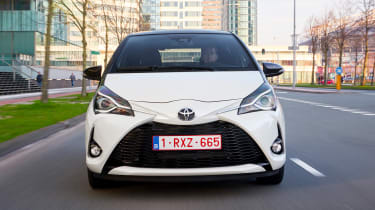Toyota Yaris hatchback (2011-2020) - Engines, drive & performance
It’s easy to drive, but the Toyota Yaris can’t entertain like a Ford Fiesta can
Hassle-free personal transport is what the Toyota Yaris is all about, and its light controls and tight turning circle make it perfectly suited to negotiating the urban jungle. Parking couldn’t be easier, but if reversing into tight spots isn’t something you savour, you can always go for the Icon model or above, all of which have a useful reversing camera.
Being easy to manoeuvre is one thing, but if you yearn for a little bit more, the Yaris comes up short when compared to the likeable Ford Fiesta. Even after the facelift in early 2017, the Yaris still feels like a car designed for comfort rather than rewarding handling.
In comparison, the Ford’s steering gives you the feedback needed for confidence in corners, and although there’s some body lean to contend with, it’s better controlled than the Toyota’s and unlikely to catch you off guard. Nor does the Fiesta suffer from the detached feeling of the Yaris at speed. The Yaris also lags behind the Mazda2 and the Volkswagen Polo when it comes to driving fun.
Toyota Yaris petrol engines
Toyota’s basic 1.0-litre petrol engine feels underpowered at all but town speeds and a 0-62mph time of 15.3 seconds means you’ll need plenty of space (and some bravery) to complete A-road overtakes safely.
If you plan to use your Yaris for the occasional long motorway jaunt, the 1.5-litre petrol model is a better choice – it gets from 0-62mph in a more respectable 11 seconds and is quieter at a cruise. While we recommend the petrol for the Yaris, it’s hard to ignore that the 1.0-litre TSI petrol in the Polo claims better official economy and is significantly quicker, getting from 0-62mph in 9.3 seconds.
Hybrid engine
When the Yaris Hybrid was exempt from the London Congestion Charge it made sense for anyone who regularly negotiated our nation’s capital, but now that it no longer meets the 75g/km CO2 requirement it’s hard to recommend; you’ll quickly tire of the constant drone from the CVT automatic gearbox when gathering pace. This CVT transmission is also available with the 1.5-litre petrol engine but we’d advise that you stick with the manual if you can.
Those seriously contemplating a Yaris Hybrid might want to wait for the fourth generation Yaris to go on sale, due in the summer of 2020. It will feature a heavily revised Hybrid system and an improved CVT automatic gearbox. It could also be a good choice for London commuters, as with a claimed CO2 emissions figure of 65g/km, it is exempt from the London Congestion Charge.












